Creek Tower Dubai: Current Status and Future Prospects
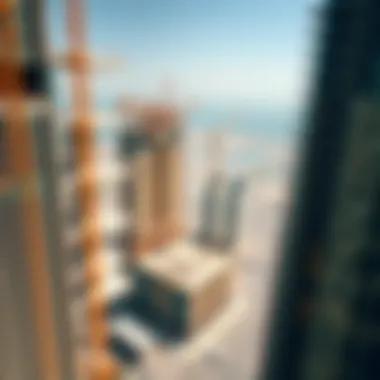
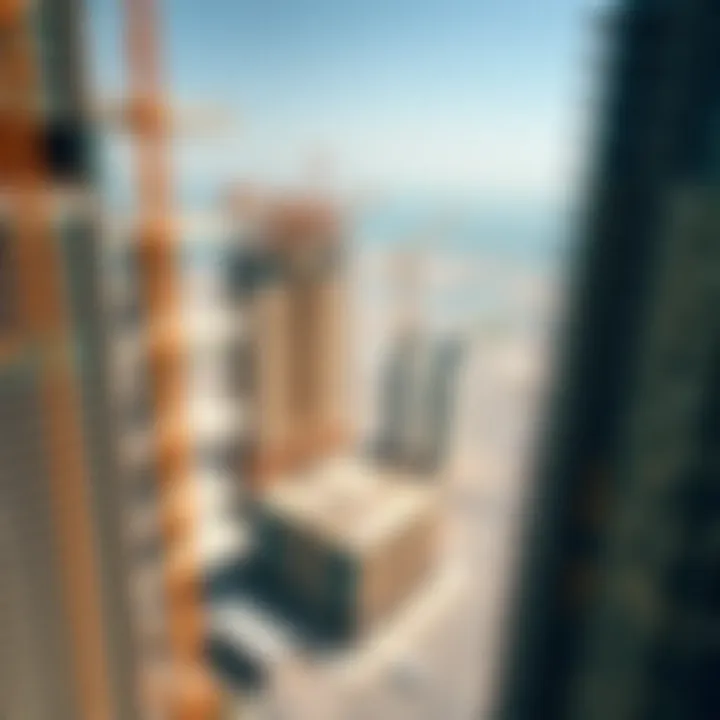
Intro
The development of the Creek Tower in Dubai is not just an architectural endeavor; it’s a reflection of the city’s ambition to redefine its skyline and reinforce its status as a global business hub. Dubai's zeal for innovation and luxury is palpable, and the Creek Tower is positioned at the forefront of this movement. With its striking design and monumental height, the tower promises to be one of the crown jewels of Dubai.
This article will take a closer look at the progress of Creek Tower, dissecting its architectural complexities, engineering feats, and the significant challenges faced thus far. In addition, we'll explore the implications this giant structure will have on the local real estate market, providing investors and potential homeowners insights into the evolving landscape of opportunities in Dubai.
Expect an engaged discourse as we navigate through market insights, investment strategies, and the future prospects of this iconic development. Alright, let’s dive into the particulars of this ambitious project and what it means for Dubai and beyond.
Market Insights
Current Trends in Dubai Real Estate
Dubai's real estate market is in a state of dynamic evolution, with several trends shaping its future. The ongoing construction of Creek Tower is a testament to the city's resilience and its capacity for growth. Recent years have seen a resurgence in demand for luxury properties, driven largely by the influx of foreign investment and expatriate communities.
Several factors contribute to this resurgence:
- Strong Economic Recovery: Post-pandemic, Dubai's economy has rebounded significantly, attracting global investors who are seeking a safe haven for their capital.
- Government Initiatives: The Dubai government's policies, aimed at facilitating foreign ownership and enhancing the ease of doing business, have played a critical role in stimulating the real estate sector.
- Sustainable Development Focus: With a push towards green living and sustainability, new projects, including Creek Tower, are designed to offer not just luxury but also eco-friendly features that appeal to modern investors.
Key Indicators of Market Performance
To gauge the health of the Dubai real estate market, it’s essential to examine several key indicators:
- Sales and Rental Prices: Recent trends indicate a steady increase in sales prices, particularly in high-end segments, while rental prices have started to stabilize after a period of decline.
- Transaction Volume: The number of real estate transactions has surged, suggesting increased buyer confidence and market activity. In fact, reports indicate a 20% increase in transactions in the first quarter of 2023 alone.
- Occupancy Rates: With new projects like Creek Tower on the horizon, occupancy rates in surrounding areas are expected to rise, further driving demand.
"Investing in Dubai real estate is not merely about brick and mortar; it's about being part of a vibrant, growing ecosystem."
As the Creek Tower rises, it not only reaffirms the luxurious lifestyle that Dubai offers but also positions itself as a catalyst for further growth in the region’s real estate market.
Investment Strategies
Smart Buying Tips for First-Time Investors
For those looking to dip their toes into Dubai's real estate waters, understanding the landscape can be a daunting task. Here are some essential tips:
- Research Thoroughly: Familiarize yourself with the areas around Creek Tower. Investigate costs, amenities, and developments that could influence future values.
- Long-Term Vision: Real estate is generally a long-term investment. Consider how your property will appreciate over time, especially with the growth driven by developments like the Creek Tower.
- Engage Professionals: Consulting with real estate agents who know the local market inside out can provide you with invaluable information and help you secure the best deals.
Understanding Rental Yields and ROI
A vital aspect of investing in real estate is understanding potential returns. In Dubai, rental yields can vary significantly based on location, type of property, and market trends. Here’s a breakdown:
- Average Yields: Many analysts suggest that favorable rental yields in Dubai range between 5-7%, with some luxury properties yielding even higher in central locations.
- Location Matters: Areas close to Creek Tower are likely to see enhanced yield potential as the infrastructure develops and the desirability of living nearby increases.
- Future Value: Consideration of the long-term value appreciation is essential, particularly in a city that is consistently expanding and seeking international acclaim.
Prelude to Creek Tower
The Creek Tower is not merely another skyscraper rising from Dubai's sands; it's a statement of ambition, innovation, and a hallmark of the city’s relentless quest for redefinition in the modern architectural landscape. As Dubai continues its transformation into a global hub for commerce, tourism, and lifestyle, this project signifies not just growth but a symbol of aspiration.
Overview of the Project
The journey of Creek Tower began amid significant fanfare, aimed at eclipsing its predecessors by height. Designed to reach well beyond the 1,000 meter mark, Creek Tower stands poised to overshadow the iconic Burj Khalifa, pushing the boundaries of what was previously considered possible in high-rise construction. Its design concept pays homage to cultural elements; resembling a minaret or flower, thus contextualizing it within Dubai's unique heritage. This duality of cultural respect and architectural progress serves to connect the past with the future, ensuring the tower's place in the heart of Dubai.
To achieve this audacious vision, the project harnesses cutting-edge construction techniques, aiming for completion in the next few years. The overall goal is straightforward yet profound: to enhance Dubai's skyline while presenting a new icon that attracts investments, tourism, and a set of business opportunities.
Significance within Dubai's Skyline
Creek Tower's importance transcends mere aesthetics or height; it acts as a catalyst for the entire region's economic and social dynamics. The construction of this tower heralds a new era for Dubai's urban landscape. Its presence will inevitably lead to increased property values in surrounding areas, sparking a ripple effect across the real estate market. Moreover, it signifies Dubai's ambition to remain on the cutting edge of global trends, fostering a sense of pride among residents and positioning the UAE as a leader in architectural innovation.
"A skyline is more than just buildings; it's a reflection of collective dreams and identities, and the Creek Tower epitomizes Dubai's aspiration to lead on the world stage."
The project further builds upon Dubai's narrative as a destination for luxury and high-profile events. As an architectural marvel, it is expected to attract thousands of visitors yearly, amplifying tourism revenues and providing grounds for expanded hospitality offerings, ranging from upscale shopping to fine dining.
As Creek Tower approaches its completion phase, it symbolizes more than just a stand-alone structure—it embodies the shared dreams and forward-looking ethos of Dubai. The tower’s role is pivotal, not only in enhancing the aesthetics of the skyline but also as a beacon that represents the future of sustainable and innovative urban living.
Construction Milestones
The journey of the Creek Tower in Dubai reflects a tapestry of ambition and intricate planning. Each milestone marks a crucial step in the development of this architectural marvel, showcasing both the potential and challenges of such an imposing structure. Understanding the construction milestones allows stakeholders — whether investors or analysts — to gauge not just progress, but also the feasibility of timelines and the importance of the project within Dubai’s ever-evolving skyline.
Initial Groundwork
Initiating any large-scale construction project begins with extensive groundwork, laying a solid foundation both literally and metaphorically. For Creek Tower, initial groundwork encompassed site preparation and extensive geological surveys. This phase was not merely a formality; it was crucial for determining soil stability, crucial in a region known for its sandy terrain. Engineers employed specialized drilling techniques to extract soil samples, while geotechnical assessments helped to ascertain if the chosen site could support a tower of this expected height and weight.
Establishing proper drainage systems and ensuring environmental compliance also made their mark in this stage. The environmental considerations, particularly around the water table and nearby ecosystems, proved to be focal points. This groundwork set the stage for deeper excavation and the installation of necessary supports, thus ensuring that the tower would not merely rise, but do so with strength and resilience.
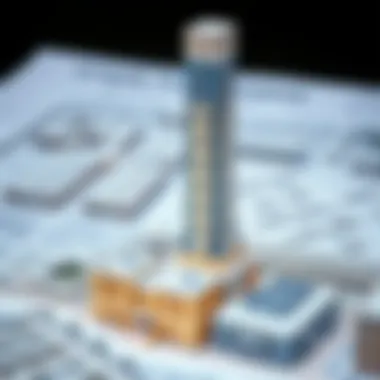
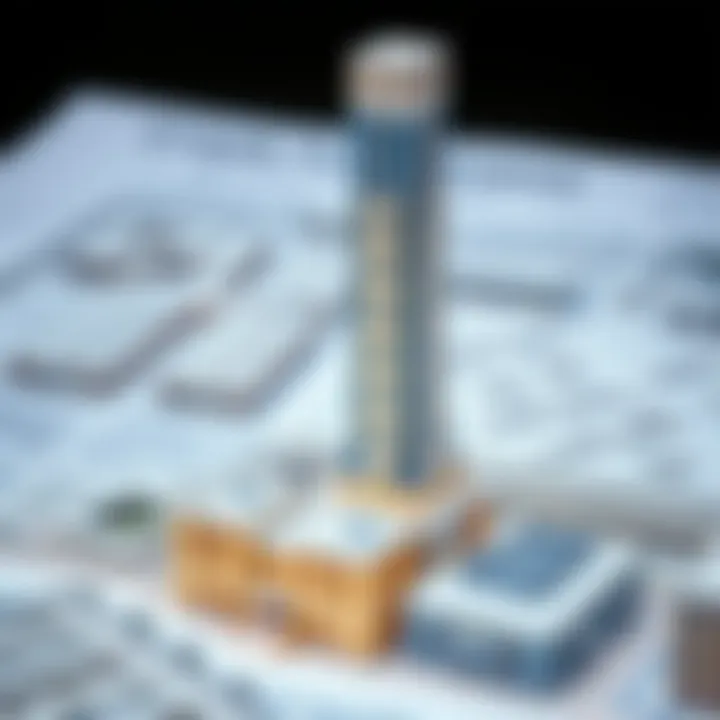
Structural Framework Development
With a robust groundwork in place, the focus shifted towards the structural framework development. This stage is akin to constructing the skeleton of a human body; it gives form and stability while allowing flexibility for future developments. Engineers opted for a unique combination of reinforced concrete and advanced steel to craft this architectural wonder. Such an approach not only enhances the tower’s stability but also allows for innovative design elements that will catch the eye.
Key highlights of this phase include:
- Integration of cutting-edge technology: Utilization of Building Information Modeling (BIM) software facilitated real-time tracking of progress and misalignments, aiding in accurate construction.
- Safety measures: Safety protocols were strictly enforced to protect workers during the installation of steel beams, a crucial undertaking, given the height limitations.
- Design adaptations: Early challenges influenced design adaptations that have potential future implications for taller structures in the region.
Notably, the commitment to sustainability complications ensured that any resulting waste was minimized and planned for environmentally friendly disposal.
Recent Progress Updates
As of the latest updates, construction is, in fact, moving ahead at an impressive pace. Recent weeks have seen notable vertical progress, with emerging structural elements hinting at the tower's distinctive silhouette against the Dubai skyline. This segment remains critical as it not only contributes to visual esthetics but also speaks volumes about the expected completion timeline.
Recent updates revealed:
- Height achievement: As of now, the tower has reached approximately 40% of its intended height. This is a compelling milestone, considering that it is designed to surpass the iconic Burj Khalifa upon completion.
- Logistics management: A sophisticated logistics plan has been executed to ensure smooth material supply, reducing downtime, and optimizing work shifts effectively.
- Engagement with local communities: Community engagement initiatives have flourished, aiming to keep the public informed while emphasizing benefits to local businesses during and post-construction.
"The Creek Tower project encapsulates a blend of modern engineering and cultural resonance, potentially reshaping not just Dubai's skyline, but also the economic dynamics of the surrounding areas."
As these construction milestones continue to unfold, the implications for Dubai’s real estate and tourism landscape remain profound.
Architectural Overview
The architectural overview of the Creek Tower is pivotal not just in understanding its physical form, but also in grasping the aspirations behind such a monumental project. It reflects the vision for Dubai as a city that stands as a beacon of modernity and innovation, encapsulating the artistry of design while meeting functional requisites. The consideration of architectural elements combines aesthetics with purpose, all while aligning with the broader context of the Dubai skyline.
Design Philosophy
The design philosophy behind the Creek Tower offers insight into its intended role within the urban landscape. Designed by the renowned architecture firm Emaar Properties, the tower seeks to embody a graceful silhouette that speaks to both heritage and forward-thinking design. Its inspiration stems from the cultural roots of the region, blending traditional Islamic motifs with contemporary architectural techniques.
For instance, the use of arcs and domes references local architectural traditions while elevating them to resonate with today's aesthetic values. The overall concept aims to create a vertical city in the sky, where every aspect, from public spaces to residential areas, encourages interaction and community engagement. The focus on sustainability also informs the design philosophy, as the structure aims to minimize environmental impact through thoughtful integration of green technologies and practices.
Height and Scale Considerations
Height and scale play essential roles in the Creek Tower's identity. Standing at an estimated 928 meters, it is set to be one of the tallest structures in the world, significantly altering the Dubai skyline. This ambitious height is not merely a matter of competition; it represents a new era in architectural boldness, showcasing human ingenuity in constructing high-rise structures.
The considerations surrounding its height involve not just engineering capabilities but also psychological impacts. A taller structure often serves as a landmark, a point of reference that enhances the city's allure. Furthermore, the scale must correspond with the surrounding developments—balancing the majestic presence of the tower with functional spaces below. It will provide panoramic views that cater to tourists and residents alike, enriching the experience of being in Dubai.
Innovation in Materials Used
The innovation found within the materials used for the Creek Tower merits attention. Utilizing state-of-the-art components, the project harnesses both local resources and advanced technologies to form a resilient structure capable of withstanding environmental challenges. For instance, special concrete mixes are designed to reflect thermal energy, helping to regulate indoor temperatures efficiently, which is crucial in the hot desert climate.
Moreover, glass facades with energy-efficient coatings will allow natural light to flood the interiors while keeping heat at bay. Such material choices are driven by a commitment to sustainability and performance, ensuring that the tower will not only stand the test of time but also uphold Dubai's emerging status as a leader in innovative architectural practices.
Engineering Challenges
The engineering hurdles faced in the construction of Creek Tower are nothing short of monumental. These challenges aren't just bumps in the road; they define how the project progresses and, ultimately, its success. Given Dubai's ambitious skyline, the Creek Tower is set to take its place among giants, which calls for innovative solutions and meticulous planning. A detailed understanding of the various elements—geological, technological, and coordination aspects—can illuminate how these challenges are being addressed and what benefits emerg from resolving them.
Geological and Environmental Factors
Digging down to the nitty-gritty, geological conditions play a critical role in construction projects, especially towering structures like Creek Tower. The site lies on a mixed terrain, featuring both solid rock and softer substrate, which can complicate the foundational work.
- Soil Composition: The needs for extensive geotechnical investigations are paramount. Factors like soil type, water table levels, and seismic activity must be examined thoroughly to prevent structural failure years down the line.
- Environmental Impact: Construction that alters the landscape carries environmental implications that cannot be ignored. Builders must ensure that the project complies with Dubai’s stringent ecological guidelines, and address issues such as local biodiversity and water management.
In navigating these challenges, engineers continually adapt designs to ensure stability and safety, yielding benefits not only for the project but for the surrounding community.
Technological Integration
When it comes to modern architecture, the integration of technology is more than a trend; it's a necessity. The Creek Tower employs cutting-edge technology that impacts both design and functionality.
- Building Information Modeling (BIM): This system allows for real-time visualization and collaboration among stakeholders. It streamlines processes, aiding in everything from design tweaks to construction modifications. Thus, minimizing potential cost overruns or delays.
- Smart Materials: Innovations such as self-healing concrete and energy-efficient glass are used, which not only enhance longevity but also contribute to sustainability goals. As technology modifies what’s considered feasible, the challenges often shift towards ensuring that these advanced methods don't compromise safety.
Adapting these technologies requires not just engineering skill but an open-mindedness to approach problems from fresh angles.
Project Management and Coordination
The scale of a project like Creek Tower necessitates rigorous project management and expert coordination across various teams and disciplines. Working harmoniously keeps things on track and on budget while navigating the myriad engineering challenges.
- Stakeholder Engagement: From architects to local government, aligning expectations is crucial. Clear communication strategies are established to ensure that all parties are on the same page.
- Risk Assessment: Identifying potential pitfalls ahead of time allows project managers to devise applicable mitigation strategies. This preemptive action is invaluable in coping with unknown factors that could arise during construction.
- Timeliness and Resource Allocation: Efficiently managing resources—whether manpower, materials, or financial—is key to minimizing waste and ensuring that timelines are adhered to.
Maintaining coordination among such varied elements can indeed feel like herding cats. Yet when it's done right, the results can transform challenges into gateways for unparalleled success in building the remarkable.
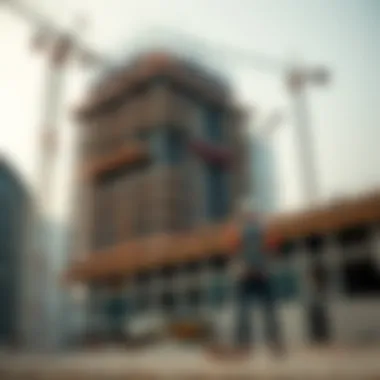
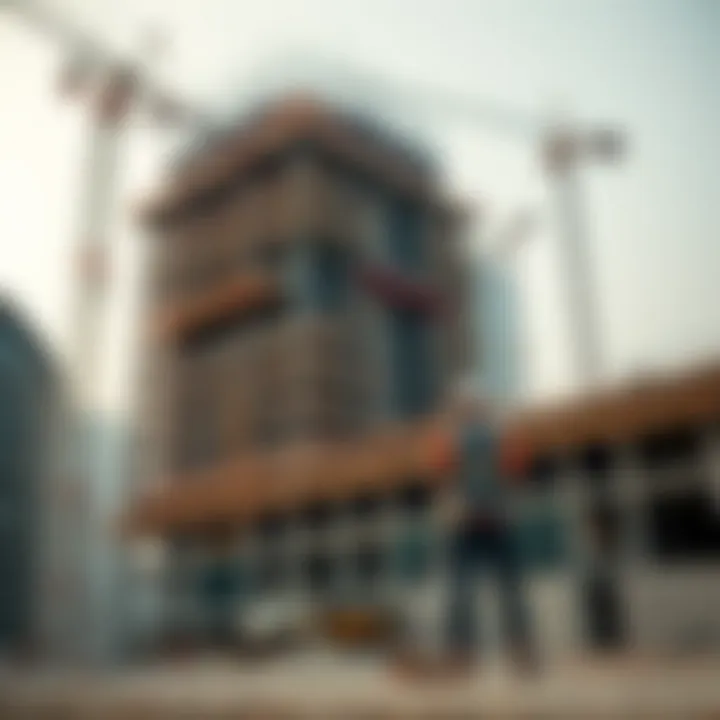
Projected Completion Timeline
The projected completion timeline for the Creek Tower is pivotal not just for construction stakeholders, but also for the local community and broader economic environment. It illustrates the progress being made in one of the most ambitious projects in Dubai's architectural landscape. Understanding this timeline can help various parties—from investors to future residents—strategically align their plans with the expected openings and operational dates.
Current Project Schedule
As of now, the current project schedule indicates a steady pace in construction, with several key phases having been achieved within the stipulated timeframes. Recent updates suggest that the construction teams have made important strides, laying down essential structures and integrating advanced technologies that define the Creek Tower's unique architectural features. The project timeline plan includes:
- Completion of the main structural framework by early 2024.
- Installation of the distinctive glass façade by mid-2024.
- Anticipated internal finishes and landscaping enhancements by late 2024.
- Official opening aimed for early 2025, pending no substantial delays.
The close monitoring of these timelines is crucial for a range of stakeholders, including local businesses and potential investors who are waiting in the wings to tap into the economic opportunities this landmark will likely generate.
Anticipated Delays and Mitigations
While the project is progressing well, it's important to acknowledge that such large-scale constructions often encounter unforeseen delays. Factors contributing to potential hold-ups can include:
- Supply Chain Disruptions: Challenges in sourcing materials can slow down construction efforts.
- Labor Shortages: Unexpected fluctuations in the availability of skilled labor may also hinder progress.
However, the project management team is not blind to these challenges; measures have been put in place to minimize their impact. For instance:
- Alternative Suppliers have been qualified to ensure material availability.
- Extra shifts are planned to ramp up construction efforts during peak times, thus offsetting labor shortages.
These mitigations are designed to keep the schedule on track while maintaining high-quality standards.
Future Milestones to Watch
Looking ahead, several future milestones warrant close attention. These include:
- Technical Reviews in mid-2024 to ensure compliance with safety standards.
- Final Aesthetic Touches by late 2024 that are expected to bring life to the exterior and interior spaces.
- Mock Openings for select groups in early 2025 can offer the public a sneak peek while providing crucial feedback before the official launch.
Monitoring these milestones is vital as they serve as indicators not just of the project's progress, but also of the wider reception it might expect from the community.
Economic Implications
The construction and completion of Creek Tower in Dubai carries with it a ripple effect that extends well beyond its immediate vicinity. The economic implications of this monumental project can be dissected into several layers, encompassing not just immediate financial investments but also broader influences on real estate, tourism, and long-term urban development. Understanding these elements is essential for investors, homeowners, and analysts alike, as they navigate the ever-evolving landscape of Dubai's economy.
Influence on Local Real Estate Market
Creek Tower's emergence is poised to significantly shape the local real estate market. With its unique architectural features and towering presence, the project taps into the allure of Dubai's skyline. As it rises, so too does interest among foreign and local investors. Specifically, residential and commercial spaces in surrounding areas are seeing a surge in demand. Property values are likely to increase in tandem with the tower's completion, making it a prime target for investment endeavors.
- Rising Property Values: The tower alone can stimulate growth, leading to an upward trajectory in property prices.
- Increased Rental Demand: As more people flock to the area for employment and leisure opportunities, rental demand is expected to spike.
- Gentrification and Urban Renewal: With the influx of new developments, older neighborhoods may see renovations and enhancements, breathing new life into the community.
This increased activity can be visualized as a domino effect; as one property sees appreciation, others nearby follow suit, enhancing the overall ecosystem of the area.
Investment Opportunities Arising from Development
With Creek Tower drawing attention, myriad investment opportunities unfold. The project not only signifies the construction of a building but the development of an entire economic ecosystem that invites others to take part.
- Collaborations: Development firms can look into partnerships with local businesses to create synergies that maximize the appeal of the area.
- Retail Ventures: With residents and tourists flocking to the area, there will be a demand for services and amenities, opening doors for retail investments.
- Hospitality Ventures: Given Dubai’s status as a tourist hotspot, opportunities for hotels and boutique stays will multiply as the tower becomes a landmark attraction.
Ultimately, such opportunities not only promise robust financial returns but can also create jobs and bolster community engagement within the neighborhood.
Impact on Tourism and Business
As a future hallmark of Dubai's architectural prowess, Creek Tower is poised to attract tourists from around the globe. In this respect, its impact on tourism and local business is profoundly significant. A few elements stand out:
- Tourism Magnet: The tower’s futuristic design and anticipated observatory will lure visitors, providing a landmark that reinforces Dubai's image as a destination hub.
- Increased Foot Traffic: As tourists visit the tower, surrounding businesses will benefit from the influx of potential customers, ranging from shops to eateries.
- Event Space Utilization: Future events, exhibitions, and conferences hosted within or near the tower will stimulate the local economy, creating a vibrant atmosphere for business activities.
Sustainability and Environmental Considerations
When delving into the complexities of the Creek Tower project in Dubai, the discussion of sustainability and environmental considerations takes center stage. As urban areas expand rapidly, the significance of integrating eco-friendly practices into skyscraper development becomes paramount. The approach to sustainability not only aims to reduce environmental impact but also enhances the quality of life for residents and visitors alike. By considering sustainable practices, the developers are attempting to create a blueprint that other projects might emulate, ensuring they meet not only economic goals but also ecological ones.
Green Building Initiatives
The Creek Tower embodies a variety of green building initiatives, which serve to mitigate its ecological footprint. A notable example is the use of sustainable materials during construction, which leads to less waste and requires less energy to produce. Materials that are locally sourced can reduce transportation emissions drastically. Additionally, the implementation of advanced waste management systems during construction shows a commitment to minimizing landfill contributions.
Another initiative involves the incorporation of green roofs and vertical gardens, which not only beautify the building but also help to regulate temperature and absorb rainwater, thereby reducing runoff and promoting biodiversity. Furthermore, the design includes provisions for accommodating solar panels, tapping into renewable energy sources that align with global trends towards sustainability.
Energy Efficiency Measures
Energy efficiency is a crucial element in the Creek Tower's development strategy. The architects and engineers are exploring various energy-efficient technologies which are essential to reducing the energy consumption of the building post-completion. Smart lighting systems that adjust based on natural light levels can significantly cut electricity usage. Likewise, high-performance glazing on windows enhances insulation, reducing the need for heating and cooling.
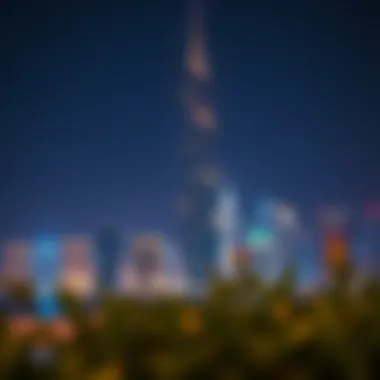

Additionally, the incorporation of natural ventilation systems is being considered, allowing fresh air to circulate without the continuous use of HVAC systems. Such innovations not only contribute to lower operational costs but also support the broader initiative of reducing greenhouse gas emissions. By making these energy efficiency measures standard, the project aspires to stand at the forefront of modern sustainable architecture.
Long-term Sustainability Goals
Looking further down the road, the long-term sustainability goals for the Creek Tower aim higher than mere compliance with regulations; they stretch into creating a legacy. One essential aspect is to engage in community-driven initiatives, fostering an urban environment that prioritizes livability alongside functionality. The intent is to create spaces where accessibility and community engagement flourish—think pedestrian parks and green spaces that invite people to connect with nature in the heart of a bustling metropolis.
Moreover, the project's long-term goals include maintaining updated sustainability practices that adapt to technological advancements and changing ecological conditions. The commitment to ongoing assessments post-construction will ensure that the building remains efficient and responsive to its environment.
The endeavor to blend sustainability with skyscraper design in Creek Tower offers a multifaceted approach, addressing today’s environmental concerns while laying the groundwork for the future.
Exploring sustainability in architecture is no longer a trend; it's become a necessity that defines how urban centers evolve responsibly.
In closing, as the Creek Tower rises amidst Dubai’s skyline, it not only seeks to showcase architectural brilliance but also aims to set a precedent for the integration of sustainable practices in urban development.
Public Reception and Community Impact
The ongoing construction of the Creek Tower in Dubai has garnered an array of reactions from the public, which makes understanding public reception and its community impact a vital aspect of this project.
Every ambitious development like the Creek Tower does not exist in a vacuum; it interacts with the lives of the people surrounding it. As a structure that aspires to dominate the skyline, communal feelings and reactions could shape not only the tower's future but the broader vicinity as well. The importance of community engagement can't be understated; it stands to foster public support or conversely, raise challenges that could delay the project or lessen its inhabitants' quality of life. This section will unwrap the threads that connect the Creek Tower's development to community dynamics, highlighting how ongoing dialogues can bring benefits and even mitigate tensions.
Community Engagement in Development Plans
Community involvement in projects like the Creek Tower allows stakeholders to share their thoughts and aspirations for the building's impact. This engagement can be in the form of public forums, surveys, or open discussions where feedback is not only welcomed but encouraged. For example, local community groups have initiated conversations about how such a structure might influence traffic patterns or local businesses. When developers listen to these voices, they can often adapt projects to better suit the needs and desires of the community. Here are some of the elements to consider in this engagement process:
- Feedback Mechanisms: Public surveys or town halls help serve as avenues to gather opinions and concerns from residents.
- Transparency in Communication: Keeping neighbors informed fosters trust and minimizes objections.
- Collaborative Solutions: Partnering with local organizations could lead to solutions that benefit not just the tower but the community at large.
Public Perception and Anticipation
Public perception regarding the Creek Tower fluctuates. Some citizens eagerly await the completion, seeing it as a symbol of progress and innovation. Others remain apprehensive, worrying about potential implications for their daily lives, such as noise, pollution, or changes in local dynamics.
Interestingly, the anticipation surrounding the project has led to both excitement and skepticism. Many in the real estate sector view the tower as a magnet for investment and tourism, potentially revitalizing the local economy. In contrast, long-time residents may feel a sense of loss as their familiar landscapes undergo transformation. The duality of this perception highlights a critical concern—
"New construction often brings a mix of hope and worry, reflecting the complexity of urban development today."
To sum up, as the Creek Tower continues to rise, understanding public sentiment represents an essential thread woven through the fabric of its existence. Stability of community relations may dictate the ultimate success of the tower, guiding it from mere concrete and steel to a cherished part of Dubai's identity.
Future Developments in the Area
The Creek Tower project symbolizes a major transformation in Dubai's skyline. However, it’s not just the tower that will shape the future of the area; there are numerous ancillary developments at play. The importance of examining future developments lies in understanding how they complement the Creek Tower, enhance urban planning, and provide a broader perspective on Dubai's real estate market. As this environment evolves, there are several specific elements to consider: the enhancement of surrounding infrastructure and the initiation of complementary projects.
Surrounding Infrastructure Enhancements
Enhancements to surrounding infrastructure are pivotal in creating a seamless integration between the Creek Tower and the broader community. One major focus area is transportation. Improvements to the road networks and the expansion of public transport options will not only alleviate congestion but also provide residents and visitors with better access to the tower and its amenities.
An example of such an enhancement is the proposed expansion of the Dubai Metro system, with new lines connecting directly to areas surrounding the Creek Tower. This addition can significantly reduce travel time across the city and boost connectivity. Additionally, the inclusion of biking paths and pedestrian-friendly avenues enhances overall mobility. Ideally, these adjustments will cater to a larger populace, including investors, homeowners, and visitors who flock to explore what the tower and its vicinity have to offer.
Moreover, utilities infrastructure is being upgraded to meet the needs of this burgeoning area. Enhanced water supply lines, electricity grids, and internet connectivity will ensure that the development is sustainable and able to support its residents in the long term. Such upgrades not only improve the quality of life but also significantly raise property values in the area.
Complementary Projects in the Pipeline
In tandem with the Creek Tower, several complementary projects are making waves in the planning phases or under construction. These developments are designed to synergize with the tower, creating a vibrant community hub.
One of the notable projects is the development of the Dubai Creek Harbour, a mixed-use community that focuses on living, entertainment, and retail. This project aims to provide more than just residential units; it intends to create a bustling environment filled with parks, retail stores, and cultural spaces. The emphasis on a holistic lifestyle experience ensures that residents will have everything they need within walking distance.
Another project which might be on the horizon is the introduction of luxury hotels and hospitality venues near the tower. This side of development draws on Dubai's established reputation as a travel destination, aiming to attract international tourists while also catering to business travelers. By ensuring that high-standard accommodations are readily available, developers can capitalize on the flow of visitors drawn to the Creek Tower.
The combination of these complementary projects with surrounding infrastructure improvements means that the Creek Tower will not function in isolation. Instead, it will become part of a well-integrated urban tapestry, enhancing not just its immediate vicinity but enriching the entire Dubai experience for investors, residents, and, of course, tourists.
In essence, the future developments in the area surrounding the Creek Tower are designed to create a cohesive, dynamic environment that embodies modern urban living while supporting sustainable growth and community engagement.
End
The conclusion of this article distills the essence of the Creek Tower project and its significance, weaving together the various threads explored throughout. In a city like Dubai, known for its remarkable transformations and architectural marvels, Creek Tower represents not just another skyscraper; it embodies ambition, innovation, and the relentless pursuit of excellence.
Summary of Key Insights
Throughout this article, several key points emerged:
- Creek Tower’s Role: As a centerpiece of Dubai Creek’s revitalization, it stands as a symbol of modernity while enhancing the area’s status.
- Economic Impacts: The project paves the way for significant economic changes, boosting tourism, real estate, and creating job opportunities in the process.
- Sustainability Practices: Emphasizing green construction methods, Creek Tower promises to be a benchmark for future developments, aiming to minimize environmental impact and maximize energy efficiency.
These insights paint a picture of a project not only focused on height and aesthetics but one that integrates community engagement and sustainability into its core. The developments surrounding Creek Tower signal a broader urban strategy, encouraging holistic growth aligned with visions for a sustainable and prosperous Dubai.
Final Thoughts on Creek Tower's Impact
In the grand tapestry of Dubai’s architectural landscape, Creek Tower is poised to be a significant thread. Its eventual completion will likely not just influence the immediate vicinity but set a precedent for future skyscrapers within the region. Investors looking at this project will find a blend of tradition and modernity, an embodiment of Dubai’s brand ethos, inspired by cutting-edge technology and sustainable practices.
As Dubai continues to evolve, the impact of Creek Tower on the urban fabric, along with the prospective residential and commercial developments surrounding it, will be crucial to monitor. The tower’s ability to integrate seamlessly into the community while providing a sustainable future could reshape the expectations of landmark projects in the years to come.
Whether for investors, homeowners, or urban planners, Creek Tower serves as a powerful reminder that the skyline reflects not only how high we can build but also how thoughtfully we must plan for the future.







